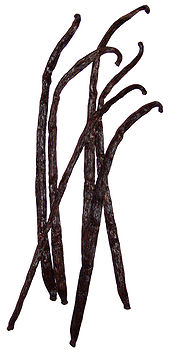– **Origin and Cultivation of Vanilla:**
– Spice derived from orchids of the genus Vanilla
– Mainly obtained from pods of the flat-leaved vanilla (V. planifolia)
– Pollination required for fruit production
– Artificial pollination attempted in 1837 by Belgian botanist
– Hand-pollination discovered in 1841 by a 12-year-old slave on Réunion
– **Historical Significance of Hand-Pollination:**
– Hand-pollination revolutionized global cultivation
– Jean Michel Claude Richard falsely claimed the technique’s discovery
– Edmond Albius, the true discoverer, recognized by the end of the 20th century
– Commercial deployment of hand-pollination led to increased vanilla production
– Three major vanilla species grown globally, originating from Mesoamerica
– **Global Vanilla Cultivation:**
– Three major vanilla species grown worldwide
– V. planifolia (Madagascar, Réunion, Indian Ocean regions)
– V. × tahitensis (South Pacific)
– V. pompona
– Regions like Madagascar and Réunion major vanilla producers
– Mesoamerican origins of vanilla cultivation
– **Economic Importance of Vanilla Production:**
– Vanilla a valuable spice in the global market
– High demand for vanilla in food, beverage, and fragrance industries
– Madagascar a significant producer of vanilla
– Vanilla prices fluctuate due to supply-demand dynamics
– Vanilla production a crucial economic activity for many regions
– **Culinary and Industrial Uses of Vanilla:**
– Vanilla widely used in culinary applications
– Flavoring agent in desserts, beverages, and savory dishes
– Vanilla used in perfume and cosmetic industries
– Vanilla extract, essence, and powder common forms
– Vanilla a versatile ingredient in various products
Vanilla is a spice derived from orchids of the genus Vanilla, primarily obtained from pods of the flat-leaved vanilla (V. planifolia).


Vanilla is not autogamous, so pollination is required to make the plants produce the fruit from which the vanilla spice is obtained. In 1837, Belgian botanist Charles François Antoine Morren discovered this fact and pioneered a method of artificially pollinating the plant. The method proved financially unworkable and was not deployed commercially. In 1841, Edmond Albius, a 12-year-old slave who lived on the French island of Réunion in the Indian Ocean, discovered that the plant could be hand-pollinated. Hand-pollination allowed global cultivation of the plant. Noted French botanist and plant collector Jean Michel Claude Richard falsely claimed to have discovered the technique three or four years earlier. By the end of the 20th century, Albius was considered the true discoverer.
Three major species of vanilla currently are grown globally, all of which derive from a species originally found in Mesoamerica, including parts of modern-day Mexico. They are V. planifolia (syn. V. fragrans), grown on Madagascar, Réunion, and other tropical areas along the Indian Ocean; V. × tahitensis, grown in the South Pacific; and V. pompona, found in the West Indies, Central America, and South America. The majority of the world's vanilla is the V. planifolia species, more commonly known as Bourbon vanilla (after the former name of Réunion, Île Bourbon) or Madagascar vanilla, which is produced in Madagascar and neighboring islands in the southwestern Indian Ocean, and in Indonesia. Madagascar's and Indonesia's cultivations produce two-thirds of the world's supply of vanilla.
Vanilla is the second-most expensive spice (as measured in terms of average price by unit of weight) after saffron because growing the vanilla seed pods is labor-intensive. Nevertheless, vanilla is widely used in both commercial and domestic baking, perfume production, and aromatherapy, as only small amounts are needed to impart its signature flavor and aroma.
